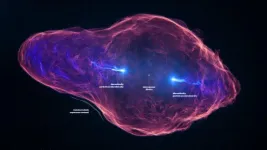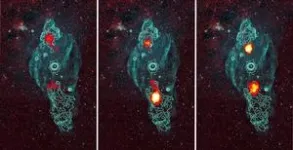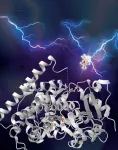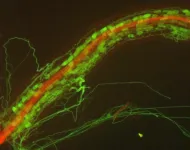(Press-News.org) The science fiction author Arthur C. Clarke selected his own seven wonders of the world in a BBC television series in 1997. The only astronomical object he included was SS 433. It had attracted attention already in the late 1970s due to its X-ray emission and was later discovered to be at the center of a gas nebula that is dubbed the manatee nebula due to its unique shape resembling these aquatic mammals.
SS 433 is a binary star system in which a black hole, with a mass approximately ten times that of the Sun, and a star, with a similar mass but occupying a much larger volume, orbit each other with a period of 13 days. The intense gravitational field of the black hole rips material from the surface of the star, which accumulates in a hot gas disk that feeds the black hole. As matter falls in toward the black hole, two collimated jets of charged particles (plasma) are launched, perpendicular to the plane of the disk, at a quarter of the speed of light (see figure 1).
The jets of SS433 can be detected in the radio to x-ray ranges out to a distance of less than one light year either side of the central binary star, before they become too dim to be seen. Yet surprisingly, at around 75 light-years distance from their launch site, the jets are seen to abruptly reappear as bright X-ray sources. The reasons for this reappearance have long been poorly understood.
Similar relativistic jets are also observed emanating from the centers of active galaxies (for example quasars), though these jets are much larger in size than the galactic jets of SS 433. Due to this analogy, objects like SS 433 are classified as microquasars.
Until recently, no gamma ray emission has ever been detected from a microquasar. But this changed in 2018, when the High Altitude Water Cherenkov Gamma-ray Observatory (HAWC), for the first time, succeeded in detecting very-high-energy gamma rays from the jets of SS 433. This means that somewhere in the jets particles are accelerated to extreme energies. Despite decades of research, it is still unclear how or where particles are accelerated within astrophysical jets.
The study of gamma-ray emission from microquasars provides one crucial advantage: while the jets of SS 433 are 50 times smaller than those of the closest active galaxy (Centaurus A), SS 433 is located inside the Milky Way a thousand times closer to Earth. As a consequence, the apparent size of the jets of SS 433 in the sky is much larger and thus their properties are easier to study with the current generation of gamma-ray telescopes.
Prompted by the HAWC detection, the H.E.S.S. Observatory initiated an observation campaign of the SS 433 system. This campaign resulted in around 200 hours of data and a clear detection of gamma-ray emission from the jets of SS 433. The superior angular resolution of the H.E.S.S. telescopes in comparison to earlier measurements allowed the researchers to pinpoint the origin of the gamma-ray emission within the jets for the first time, yielding intriguing results:
While no gamma-ray emission is detected from the central binary region, emission abruptly appears in the outer jets at a distance of about 75 light years either side of the binary star, in accordance to previous X-ray observations.
However, what surprised the astronomers most, was a shift in the position of the gamma-ray emission when viewed at different energies.
The gamma-ray photons with the highest energies of more than 10 teraelectron-volts, are only detected at the point where the jets abruptly reappear (see fig 2c). By contrast, the regions emitting gamma rays with lower energies appear further along each jet (see figure 2).
“This is the first-ever observation of energy-dependent morphology in the gamma-ray emission of an astrophysical jet”, remarks Laura Olivera-Nieto, from the Max-Planck-Institut für Kernphysik in Heidelberg, who was leading the H.E.S.S. study of SS 433 as part of her doctoral thesis. “We were initially puzzled by these findings. The concentration of such high energy photons at the sites of the X-ray jets' reappearance means efficient particle acceleration must be taking place there, which was not expected”.
The scientists did a simulation of the observed energy-dependence of the gammy-ray emission and were able to achieve the first-ever estimate of the velocity of the outer jets. The difference between this velocity and the one with which the jets are launched suggests that the mechanism which accelerated the particles further out is a strong shock- a sharp transition in the properties of the medium. The presence of a shock would then also provide a natural explanation for the x-ray reappearance of the jets, as accelerated electrons also produce x-ray radiation.
“When these fast particles then collide with a light particle (photon), they transfer part of their energy – which is how they produce the high-energy gamma photons observed with H.E.S.S. This process is called the inverse Compton effect”, explains Brian Reville, group leader of the Astrophysical Plasma Theory group at the Max Planck Institute for Nuclear Physics in Heidelberg.
“There has been a great deal of speculation about the occurrence of particle acceleration in this unique system - not anymore: the H.E.S.S. result really pins down the site of acceleration, the nature of the accelerated particles, and allows us to probe the motion of the large-scale jets launched by the black hole” points-out Jim Hinton, Director of the Max Planck Institute for Nuclear Physics in Heidelberg and Head of the Non-thermal Astrophysics Department.
“Just a few years ago, it was unthinkable that ground-based gamma-ray measurements could provide information about the internal dynamics of such a system” adds coauthor Michelle Tsirou, a postdoctoral researcher at DESY Zeuthen.
However, nothing is known about the origin of the shocks at the sites where the jet reappears. “We still don't have a model that can uniformly explain all the properties of the jet, as no model has yet predicted this feature” explains Olivera-Nieto. She wants to devote herself to this task next - a worthwhile goal, as the relative proximity of SS 433 to Earth offers a unique opportunity to study the occurrence of particle acceleration in relativistic jets. It is hoped that the results can be transferred to the thousand-times larger jets of active galaxies and quasars, which would help solve the many puzzles concerning the origin of the most energetic cosmic rays.
The H.E.S.S. Observatory
High-energy gamma rays can only be observed from the ground with a trick. When a gamma ray enters the atmosphere, it collides with atoms and molecules and generates new particles that race on towards the ground like an avalanche. These particles emit flashes lasting only a few billionths of a second (Cherenkov radiation), which can be observed with specially equipped large telescopes on the ground. High-energy gamma astronomy therefore uses the atmosphere like a giant fluorescent screen. The H.E.S.S. observatory, located in the Khomas Highlands of Namibia at an altitude of 1835m, officially went into operation in 2002 (figure 3). It consists of an array of five telescopes. Four telescopes with mirror diameters of 12 m are located at the corners of a square, with a further 28 m telescope in the center. This makes it possible to detect cosmic gamma radiation in the range of a few tens of gigaelectronvolts (GeV, 109 electronvolts) to a few tens of teraelectronvolts (TeV, 1012 electronvolts). For comparison: visible light particles have energies of two to three electron volts. H.E.S.S. is currently the only instrument that observes the southern sky in high-energy gamma light and is also the largest and most sensitive telescope system of its kind.
END
Astrophysical jet caught in a “speed trap”
How Gamma Rays Track the Velocity of the Galactic Microquasar SS 433’s Jets and Uncover Highly Efficient Particle Acceleration.
2024-01-25
ELSE PRESS RELEASES FROM THIS DATE:
Experts call for major shift in international decision-making to tackle ‘devastating’ impact of urban expansion and avoid ‘planetary catastrophe’
2024-01-25
Leading scientists are today calling for an urgent step change in global governance to save the future of worldwide cities and the planet at large.
Cities are growing at an unprecedented rate, putting overwhelming pressures on exploited land, scarce resources, and fragile ecosystems. The bold proposals, led by experts from the Universities of Bristol, Oxford and Yale, are set out in a Science journal article, proposing a new global advisory system to address the alarming impacts of urban expansion. This system would fulfil a similar function as the Intergovernmental ...
Teaching nature to break man-made chemical bonds
2024-01-25
For the first time, scientists have engineered an enzyme that can break stubborn man-made bonds between silicon and carbon that exist in widely used chemicals known as siloxanes, or silicones. The discovery is a first step toward rendering the chemicals, which can linger in the environment, biodegradable.
"Nature is an amazing chemist, and her repertoire now includes breaking bonds in siloxanes previously thought to evade attack by living organisms," says Frances Arnold, the Linus Pauling Professor of Chemical Engineering, Bioengineering and Biochemistry at Caltech and winner of the 2018 Nobel ...
Tiny ant species disrupts lion’s hunting behavior
2024-01-25
What makes the little old ant think he can disrupt the life of an African lion?
Researchers say it’s more than just high hopes.
In a study published today in the journal Science, a team of scientists reports that a tiny and seemingly innocuous invasive ant species is changing tree cover in an East African wildlife area, making it harder for lions, the world’s most iconic predator, to hunt its preferred prey, zebra.
“These tiny invaders are cryptically pulling on the ties that bind an African ecosystem together, determining who is eaten and ...
West Nile virus emergence and spread in Europe found to be positively associated with agricultural activities
2024-01-25
The spread of West Nile virus in Europe is strongly linked to agricultural activities, urbanization, and bird migration, according to a modelling study published January 25, 2024 in the open-access journal PLOS Pathogens by Lu Lu from the University of Edinburgh, UK, and collaborators belonging to a large European collaborative consortium under the VEO (Versatile Emerging infectious disease Observatory) project.
West Nile virus outbreaks have occurred in birds (the natural hosts and reservoirs for the virus), livestock, and ...
The underground network: Decoding the dynamics of plant-fungal symbiosis
2024-01-25
The intricate dance of nature often unfolds in mysterious ways, hidden from the naked eye. At the heart of this enigmatic tango lies a vital partnership: the symbiosis between plants and a type of fungi known as arbuscular mycorrhizal (AM) fungi. New groundbreaking research, recently published in the journal Science, delves into this partnership, revealing key insights that deepen our understanding of plant-AM fungi interactions and could lead to advances in sustainable agriculture.
AM fungi live within plant root cells, forming a unique alliance with ...
Jennifer Lippincott-Schwartz receives the Dickson Prize in Science
2024-01-25
Jennifer Lippincott-Schwartz, a senior group leader at HHMI's Janelia Research Campus and head of Janelia’s 4D Cellular Physiology research area, has been awarded the 2023 Dickson Prize in Science from Carnegie Mellon University for her pioneering work in live-cell imaging and organelle dynamics.
The Dickson Prize in Science recognizes substantial achievements or sustained progress in the fields of the natural sciences, engineering, computer science, or mathematics. It has been awarded annually since 1970.
Lippincott-Schwartz was recognized for her decades of work in cell biology, including the development of groundbreaking ...
Young people from poorer families make fewer friends
2024-01-25
A new study has found that children growing up in low-income families have fewer opportunities to make friends and to socially integrate at school. Researchers from the University of Zurich and the University of Stockholm examined data from over 200 school classes in Sweden and reached this conclusion.
Having friends at school is important for adolescents’ development and it shapes their social skills later in life. Teenagers who feel well integrated in their school class have better mental health and higher grades – which has a knock-on effect on their later careers.
A study led by the University of Zurich set out to examine whether parental income influences ...
#ASC2024: Ethnicity as survival predictor for gastric cancer, early liver retransplantation, risk factors for chemical restraint use among adult trauma patients and more
2024-01-25
Surgeons and scientists at UCLA Health will present data on the latest basic science, translational and health services research that has the potential to improve patient care at the 19th annual Academic Surgical (ASC) Congress in Washington, D.C., Feb. 6 to 8.
The annual meeting, which is the joint meeting of the Association for Academic Surgery and the Society of University Surgeons, will feature nearly 80 abstracts from UCLA investigators that highlight topics in subspecialties ranging from oncology, trauma surgery to cardiothoracic surgery.
Dr. Timothy Donahue, chief of surgical oncology and professor of surgery at the David Geffen School of Medicine, is the current ...
Sepsis in children: Improved diagnosis thanks to new global criteria
2024-01-25
Diagnosis of sepsis in children has been improved based on new research findings. An international research team co-led by the Luregn Schlapbach from the University and the University Children’s Hospital Zurich harnessed artificial intelligence to analyze data from over 3.5 million children suffering from this life-threatening disease.
Sepsis is a life-threatening infection that can lead to organ failure. Every year, around 3 million children worldwide die of the disease. Of those who survive a sepsis infection, every third child suffers long-term consequences, sometimes severe. Until now, there were no evidence-based criteria for diagnosing sepsis ...
Purdue Innovates licenses novel short-stature corn technology to Ag Alumni Seed
2024-01-25
WEST LAFAYETTE, Ind. – The Purdue Innovates Office of Technology Commercialization has issued a worldwide, exclusive license for a short-stature corn inbred called D16 to Romney-based Ag Alumni Seed.
The license is limited to popcorn and doesn’t apply to dent corn, field corn or sweet corn.
Traditional breeding techniques
Ag Alumni Seed has supported multiple research projects at Purdue University with both financial and in-kind contributions—such as the use of land, equipment and facilities. Jay Hulbert, the company’s president and CEO, said development of D16 began with research that Guri Johal conducted at the company’s ...
LAST 30 PRESS RELEASES:
Groundbreaking discovery turns household plastic recycling into anti-cancer medication
Blocking a key inflammatory pathway improves liver structure and vascular function in cirrhosis, study finds
Continuous spread: Raccoon roundworm detected in nine European countries
HKUST Engineering researchers developed a novel photodetector to enhance the performance of on-chip light monitoring
Strategic river sensors could have forewarned of Texas Camp flood disaster
Drone sampling of whale breath reveals first evidence of potentially deadly virus in Arctic
Roman soldiers defending Hadrian’s Wall infected by parasites, study finds
Pinochet’s prisoners were tormented with music but still found solace in it, a new book reveals
Fertility remains high in rural Tanzania despite access to family planning
AI-assisted device can improve autism care access
Kinetic careers
Uncovering how parasitic plants avoid attacking themselves to improve crop resistance
Nanoparticle vaccine strategy could protect against Ebola and other deadly filoviruses
Study finds brain care score can predict risk of stroke across racial groups
Key lung immune cells can intensify allergic reactions
Do hormones explain why women experience more gut pain?
New materials conduct ions in solids as easily as in liquids
Breakthrough of the Year: Renewable energy begins to eclipse fossil fuel-based sources
LLM use is reshaping scientific enterprise by increasing output, reducing quality and more
Introducing LightGen, a chip for ultra-fast, ultra-efficient generative AI
Astronomers see fireworks from violent collisions around nearby star
ACC/AHA issue new guideline on managing congenital heart disease in adults
Cosmic crash caught on camera
Is talented youth nurtured the wrong way? New study shows: top performers develop differently than assumed
Ants: An untapped resource in the development of antibiotics?
Archaeologists use AI to create prehistoric video game
Mitochondria migrate toward the cell membrane in response to high glucose levels
Tiny viral switch offers hope against drug-resistant bacteria
Most parents aware of early peanut introduction guidelines, but confused about details
HPV vaccine can protect against severe lesions of the vulva and vagina
[Press-News.org] Astrophysical jet caught in a “speed trap”How Gamma Rays Track the Velocity of the Galactic Microquasar SS 433’s Jets and Uncover Highly Efficient Particle Acceleration.








